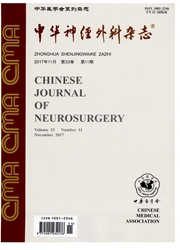

 中文摘要:
中文摘要:
目的探讨双侧去骨瓣减压术治疗重型颅脑创伤(sTBI)的临床效果。方法纳入2011年9月至2015年12月山东大学齐鲁医院急诊神经外科收治的幕上sTBI患者193例,其中106例为单侧标准大骨瓣减压(UDC)组,87例为双侧去骨瓣减压(BDC)组。回顾性分析2组的临床疗效。结果2组患者的性别、年龄、术前格拉斯哥昏迷评分及影像学病变类型差异均无统计学意义(均P〉0.05)。BDC组与UDC组术前颅内压最高值分别为(38.9±3.1)、(38.6±2.5)mmHg(1mmHg:0.133kPa),差异无统计学意义(P〉0.05);术后即刻分别为(13.2±3.1)、(18.3±3.9)mmHg,差异有统计学意义(P=0.000)。BDC组术中急性脑膨出的发生率为3.4%(3/87),低于UDC组的11.3%(12/106),差异有统计学意义(P:0.042);2组刀口愈合不良率分别为9.2%(8/87)、10.4%(11/106),差异无统计学意义(P=0.784)。术后1年随访,BDC组脑积水的发生率为8.0%(7/87),UDC组为17.9%(19/106);BDC组预后良好率为32.2%(28/87),UDC组为13.2%(14/106),差异均有统计学意义(均P〈0.05)。结论与UDC相比,BDC可减少sTBI患者术中急性脑膨出的发生率,更加有效缓解术后颅内压力,降低脑积水的发生率,明显改善患者的预后。
 英文摘要:
英文摘要:
Objective To explore the clinical efficacy of bilateral decompressive craniectomy (BDC) in the treatment of severe traumatic brain injury (sTBI). Methods A total of 193 patients with sTBI underwent treatment at Emergency Neurosurgery Department of Qilu Hospital of Shandong University and Brain Science Research Institute of Shandong University from September 2011 to December 2015. The patients were enrolled in this study and divided into standard unilateral decompressive craniectomy group (UDC group, 106 cases) and bilateral decompressive craniectomy group (BDC group, 87 cases). The clinical effects were retrospectively analyzed in the two groups of patients. Results There was no statistically significant difference in sex, age, preoperative GCS score or type of lesion on imaging between the two groups (P 〉 O. 05). The highest preoperative ICP in the BDC group and UDC group were 38.9 ± 3.1 mmHg and 38. 6 ± 2. 5 mmHg, respectively (P 〉 0. 05). The ICP in the 2 groups measured immediately post operation were 13.2±3.1 mmHg and 18.3±3.9 mmHg, respectively (P 〈 O. 001 ). The incidence of acute intraoperative encephalocele in the BDC group (3 cases, 3.4% ) was significantly lower than that in the UDC group (12 cases, 11.3% ) (P = O. 042). There was no statistically significant difference in poor incision healing between the two groups (P = O. 784). According to the follow-up 1 year after injury, the incidence of hydrocephalus in the BDC group (7 cases, 8.0% ) was significantly lower than that in the UDC group (19 cases, 17.9% ) (P 〈0.05). The outcomes of the patients were evaluated by GOS, and it was suggested that the percentage of patients with good outcomes in the BDC group (28 cases, 32.2%) was remarkably higher than that in the UDC group ( 14 cases, 13. 2%) (P 〈 0. 01 ). Conclusions For patients with sTBI, BDC could be able to help prevent the acute encephalocele during operation, decrease the ICP dramatically, reduce the incidence of
 同期刊论文项目
同期刊论文项目
 同项目期刊论文
同项目期刊论文
 期刊信息
期刊信息
